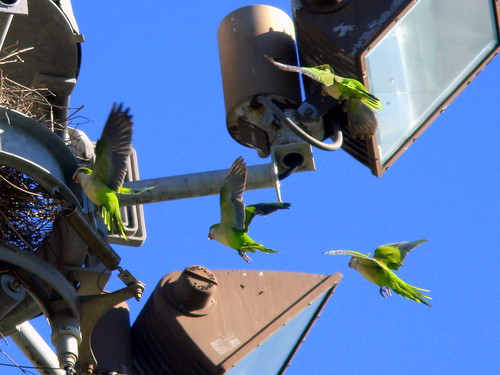 Monk parakeets. Image by Ken SchneiderThe monk parakeet population is sparking controversy in Florida for building its heavy nests on power poles, but a team of researchers may have found a safe solution to contain the birds: Feed them contraceptives.
Monk parakeets. Image by Ken SchneiderThe monk parakeet population is sparking controversy in Florida for building its heavy nests on power poles, but a team of researchers may have found a safe solution to contain the birds: Feed them contraceptives.
When built on electric utility facilities, the nests of these emerald birds, native to South America, have caused power outages and fires.
A study led by Michael Avery, courtesy professor with UF's Institute of Food and Agricultural Sciences, has found that the birds can be controlled with a contraceptive known as DiazaCon.
DiazaCon works by interfering with the birds' cholesterol levels, which affects hormones in their reproductive systems, said Avery, who is a wildlife biologist at the U.S. Department of Agriculture. Avery said that cholesterol is an essential component needed to generate the hormones that allow the birds to reproduce.
Researchers have started to combine DiazaCon, a powder-like substance, with sunflower seeds and install the mix in feeders near utility substations affected by parakeets' nests.
The contraceptive method is certainly not the first attempt to get rid of the nests. Before researchers decided to use DiazaCon, they tried laser beams, models of owls and loud noises to scare them off.
Researchers even tried to catch them by using a long-handle net that was set in front of the birds' nest entrances. After they flew into the net, they were killed with carbon dioxide, an American Veterinary Medical Association-approved technique, Avery said.
However, the only thing that seemed to work was the contraceptive, Avery said.
After two years of field study done in Miami-Dade and Broward counties, where monk parakeet nest-building was causing the worst problems, researchers found that DiazaCon reduced the number of offspring produced by about 65 percent.
Avery said the aim is not to get rid of the birds completely, but his study is intended to lower the population to help power companies.
Avery added that Gainesville is not ruled out as a potential city for monk parakeets to build their nests.
"If parakeets were released here, I see no reason why they could not become established," he said. "I would expect them to build nests on power poles and substations and cell towers just as they do elsewhere."
Jim Lindsay, principal biologist for Florida Power & Light, said researchers are currently working to keep "non-target" birds from eating the sunflower mix that carries DiazaCon.